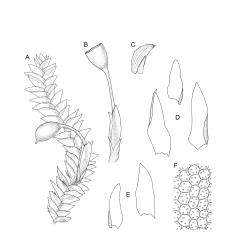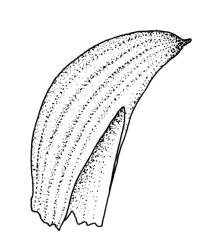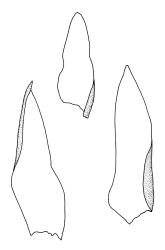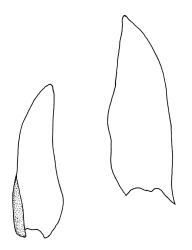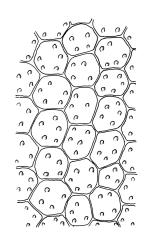- ≡ Aulacopilum glaucum Wilson, London J. Bot. 7: 90 (1848)
Plants pale grey- or blue-green, glaucous, forming loosely interwoven mats on bark; shoots c. 4–7 × c. 0.5 mm, with ± complanate, lateral branches of unequal length. Stems creeping, irregularly branched, fragile, sparsely beset with long, smooth, and red-brown rhizoids that arise in fascicles on the lower surface, in cross-section with 2 layers of incrassate cells surrounding c. 6 inner parenchyma cell layers. Branches simple or forked, mostly c. 2(–3) mm long. Stem and branch leaves similar, ecostate, in four ranks and ± complanate; leaves of the two dorsal ranks loosely spreading, asymmetrically ovate and acute to apiculate apically, mostly 0.4–0.6 × 0.2 mm, crenulate at margins due to strongly bulging cells, inrolled on lower margin, the apiculate apex often pale; leaves of the ventral ranks shorter and narrower. Upper lamina cells ± isodiametric-hexagonal, thin-walled, strongly bulging, non-collenchymatous, mostly 9–15 µm diam., with several (c. 4–9) flat-topped papillae on each surface; apical cells often pale and opaque, papillose and mostly c. 21–30 µm long; cells of lower lamina and lower margins weakly oblate but otherwise similar to those above; basal and alar cells not differentiated.
Autoicous. Perichaetia terminal on stem and branches, sheathing c. ½ the seta, with leaves ovate-acuminate and c. 0.8 mm long. Perigonia numerous, gemmiform, yellow-brown, c. 0.3 mm long, scattered on stem and branches, with bracts similar to vegetative leaves except for more rhombic cells. Setae pale, smooth, straight, twisted weakly to the right, c. 0.7–1.0 mm; capsules erect, turbinate, pale brown, gymnostomous, with a prominent columella that sometimes protrudes slightly after dehiscence, c. 0.3 × 0.2 mm; exothecial cells irregular, firm-walled; annulus not differentiated; peristome and stomata absent; operculum conic, short rostrate. Calyptra clasping at base, completely enclosing the immature capsule, with longitudinal, often twisted pleats, becoming split on one side with maturity, falling late. Spores broadly ellipsoid, thick-walled, finely papillose, 32–35(–38) µm diam.
Stone 1997, fig. 2, a–g.
NI: N Auckland (Unuwhao), S Auckland (Mayor I.), Gisborne (Raukokore River, near Whakawhitirā).
Anomalous. Stone (1997) recorded occurrences in Australia (in Qld and N.S.W.) and Argentina, Brazil, Mexico, and Sri Lanka.
The species has been confirmed from four lowland N.Z. localities. It could easily be overlooked as an hepatic if found in a sterile condition. The Unuwhao material (J.K. Bartlett 1476c, WELT M8353!) was collected from bark of Beilschmiedia tawa and was growing in part as a super-epiphyte on Frullania sp. A few stems of Fabronia australis are also present in the collection. This collection was reported by Bartlett (1985). Unuwhao is a hill overlooking Spirits Bay. The Raukokore River collection is from an unspecified tree species and includes a few stems of Haplohymenium pseudotriste. The Whakawhitirā collection by Colenso bears no habitat data but includes plants of Fabronia australis. The Mayor I. collection (P.J. de Lange 10376, AK 330305!) was collected from the bark of Vitex lucens with several species of hepatic. Stone (1997) noted that E. glaucum is often associated with Haplohymenium pseudotriste and Papillaria flexicaulis in Australia and that it occurs both on tree trunks and rock in warm temperate forests. She gave no indication of the number of Australian localities from which it was recorded.
Stone (1997, pp. 487 & 493) proposed that the South African Aulacopilum trichophyllum Müll.Hal. and the Japanese A. piliferum Noguchi should both be treated as a single variety of the present species: Erpodium glaucum var. trichophyllum (Müll.Hal.) I.G.Stone. She added (Stone 1997) that the Himalayan A. abbreviatum Mitt. and A. japonicum Cardot are likely to "prove to be closely related to Erpodium glaucum".
Stone (1997, p. 487) designated as the lectotype W. Colenso 3668a, an 1843 collection from an unspecified N.Z. locality, noting the type contained Fabronia secunda. The Fabronia mentioned by Stone can confidently be assumed to be F. australis, the only representative of that genus in N.Z. There is a single ample, undated, and unnumbered Colenso collection (WELT M31113!) from near Whakawhitirā that is also a mixture of E. glaucum and Fabronia australis. The presence of the Fabronia provides strong but circumstantial evidence that WELT M31113 is an isolectotype and that Whakawhitirā is the type locality.
A 1943 collection by G.M. O’Malley was made at the mouth of the Raukokore River, Gisborne L.D., which is c. 50 km west of the presumed type locality at Whakawhitirā. A search of the Raukokore River mouth and nearby inland forest in 1996 by A.J. Fife and D. Glenny failed to re-locate the species. The forest at the river mouth is now highly modified, and it is unlikely that the species survives there.
Erpodium glaucum is accorded Nationally Critical threat classification (Glenny et al. 2011), but efforts to protect populations are hampered by the lack of recent and precisely documented records. More exact information about populations of this species is required; Unuwhao is perhaps the most likely site where this species might be re-located and more precisely documented. Its re-location would be a first step towards its conservation management.




